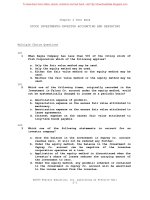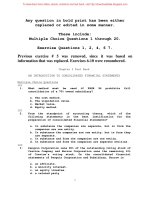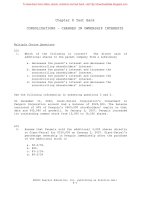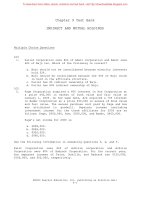Test bank strategic staffing 2e by philips gully chapter 12
Bạn đang xem bản rút gọn của tài liệu. Xem và tải ngay bản đầy đủ của tài liệu tại đây (138.16 KB, 15 trang )
Strategic Staffing, 2e (Phillips/Gully)
Chapter 12 Managing Workforce Flow
1) Orientation provides employees with the knowledge and skills they need to do their jobs.
Answer: FALSE
Diff: 1
Page Ref: 321
Skill: Concept
Objective: 1
2) Socialization programs help new employees understand the traditions of the company.
Answer: TRUE
Diff: 1
Page Ref: 322
Skill: Concept
Objective: 1
3) When coworkers show a new employee how to do their job, formal socialization is taking
place.
Answer: FALSE
Diff: 1
Page Ref: 322
Skill: Concept
Objective: 1
4) Anticipatory socialization occurs when employees receive training and begin learning about
the company culture and norms, and how to do the job.
Answer: FALSE
Diff: 1
Page Ref: 323
Skill: Concept
Objective: 1
5) Sequential socialization occurs when the steps in socialization occur in a specific order.
Answer: TRUE
Diff: 1
Page Ref: 325
Skill: Concept
Objective: 1
6) Investiture socialization programs try to strip away new hires' personal characteristics.
Answer: FALSE
Diff: 1
Page Ref: 325
Skill: Concept
Objective: 1
7) With disjunctive socialization, newcomers are left alone to develop their own interpretations
of the organization and situations they observe.
Answer: TRUE
Diff: 1
Page Ref: 325
Skill: Concept
Objective: 1
1
Copyright © 2012 Pearson Education, Inc. Publishing as Prentice Hall
8) Optimal turnover is the lowest turnover level you can achieve.
Answer: FALSE
Diff: 1
Page Ref: 328
Skill: Concept
Objective: 1
9) When a valued employee quits because his spouse takes a new job in another state, this is
unavoidable turnover.
Answer: TRUE
Diff: 1
Page Ref: 329
Skill: Concept
Objective: 1
10) When a poor performer leaves, functional turnover has occurred.
Answer: TRUE
Diff: 1
Page Ref: 329
Skill: Concept
Objective: 1
11) Exit interviews are done to inform employees why they are being let go.
Answer: FALSE
Diff: 1
Page Ref: 329
Skill: Concept
Objective: 4
12) Stock options that vest in the future create a mobility barrier for the employee receiving
them.
Answer: TRUE
Diff: 1
Page Ref: 334
Skill: Concept
Objective: 2
13) Layoffs are permanent end of the employment of employees.
Answer: FALSE
Diff: 1
Page Ref: 339
Skill: Concept
Objective: 4
14) Attrition occurs when a company hires fewer new employees.
Answer: FALSE
Diff: 1
Page Ref: 340
Skill: Concept
Objective: 4
2
Copyright © 2012 Pearson Education, Inc. Publishing as Prentice Hall
15) Having terminated employees sign a severance agreement that includes a release stating that
the departing employee gives up some or all rights to sue reduces the risk of future litigation.
Answer: TRUE
Diff: 1
Page Ref: 341
Skill: Concept
Objective: 5
16) Interacting with recruiters and future coworkers during the hiring process is the ________
phase of the socialization process.
A) anticipatory
B) encounter
C) settling in
D) onboarding
Answer: A
Diff: 1
Page Ref: 323
Skill: Concept
Objective: 1
17) Who usually has overall responsibility for conducting socialization programs?
A) coworkers
B) hiring managers
C) human resources
D) top management
Answer: C
Diff: 1
Page Ref: 323
Skill: Concept
Objective: 1
18) The first stage of the socialization process is ________.
A) settling in
B) anticipatory
C) encounter
D) expectation
Answer: B
Diff: 1
Page Ref: 323
Skill: Concept
Objective: 1
3
Copyright © 2012 Pearson Education, Inc. Publishing as Prentice Hall
19) Socialization programs putting newcomers through a common set of experiences as a group
rather than individually are called ________.
A) one-time programs
B) collective programs
C) variable programs
D) tournament programs
Answer: B
Diff: 1
Page Ref: 324
Skill: Concept
Objective: 1
20) Processing a new employee's employment-related paperwork, acquiring necessary keys and
identification cards, and establishing an e-mail account for them is part of ________.
A) socialization
B) orientation
C) attrition
D) training
Answer: B
Diff: 1
Page Ref: 321
Skill: Concept
Objective: 1
21) Denise, the human resource manager of a manufacturing company found that the company's
socialization process was too overwhelming for new hires. It consisted of presentations,
meetings, and seminars packed into the first week of joining the company. She decided to switch
into a(n) ________ approach to socializing so that new employees did not suffer from
information overload.
A) investiture
B) staggered
C) sequential
D) formal
Answer: B
Diff: 2
Page Ref: 324
Skill: Application
Objective: 1
AACSB: Analytic skills
4
Copyright © 2012 Pearson Education, Inc. Publishing as Prentice Hall
22) Earlene Gibson, the HR manager of BioMd, a manufacturer of high-end medical diagnostic
equipments, is planning to implement a socialization program in the organization. She designs a
program in which each stage of socialization is an "elimination tournament," and a new hire is
out of the organization if he or she fails. Earlene submits the program draft to the CEO for
approval. Which of the following, if true, would be the strongest counterargument for the
implementation of this plan?
A) BioMd has a strong R&D orientation and innovation and risk taking are the major values that
the company promote.
B) The management is intending to develop a homogeneous workforce that is highly cohesive
and goal oriented.
C) One of the goals of the socialization program is to exercise more discipline and control in the
organization.
D) The company is characterized by a vertical organizational structure and centralized decision
making.
Answer: A
Diff: 2
Page Ref: 324
Skill: Critical thinking
Objective: 1
AACSB: Reflective thinking skills
23) A socialization program that requires new hires to "pass" different stages of socialization or
be removed from the organization is a ________.
A) one-time program
B) collective program
C) variable program
D) tournament program
Answer: D
Diff: 1
Page Ref: 325
Skill: Concept
Objective: 1
24) The Wolverines are a leading university soccer team. All new recruits to the team must go
through certain "rites of passage" which include shaving their heads, swimming in cold water,
getting a tattoo of the team's emblem, and other tests of servitude and obedience. This is an
example of ________.
A) investiture socialization
B) disjunctive socialization
C) divestiture socialization
D) tournament socialization
Answer: C
Diff: 2
Page Ref: 325
Skill: Application
Objective: 1
AACSB: Analytic skills
5
Copyright © 2012 Pearson Education, Inc. Publishing as Prentice Hall
25) After a wave of retirements, new employees hired to replace the retirees are likely to
experience what type of socialization?
A) disjunctive
B) serial
C) informal
D) transitory
Answer: A
Diff: 1
Page Ref: 325
Skill: Concept
Objective: 1
26) ________ has been found to enhance new hires' loyalty and reduce their turnover. .
A) Socializing new employees as a group
B) Using random socialization methods
C) Disjunctive socialization
D) Informal socialization methods
Answer: A
Diff: 1
Page Ref: 327
Skill: Concept
Objective: 1
27) What is optimal turnover?
A) It is the lowest turnover that a firm can achieve.
B) It produces lowest level of long-term productivity.
C) It produces the highest level of long-term business improvement.
D) It sees any employee turnover as a loss for the company.
Answer: C
Diff: 1
Page Ref: 328
Skill: Concept
Objective: 1
28) When a call center fires an employee who cannot meet her call volume goals, which of the
following types of turnover has occurred?
A) dysfunctional
B) functional
C) avoidable
D) voluntary
Answer: B
Diff: 1
Page Ref: 329
Skill: Concept
Objective: 2
6
Copyright © 2012 Pearson Education, Inc. Publishing as Prentice Hall
29) A layoff is an example of which type of turnover?
A) dysfunctional
B) voluntary
C) involuntary
D) avoidable
Answer: C
Diff: 1
Page Ref: 329
Skill: Concept
Objective: 2
30) Which of the following is true of voluntary turnover?
A) It occurs especially if employees' job duties are well-defined.
B) It has been proven that average performers are most likely to quit.
C) It reduces when the economy is good and vice versa.
D) It can be reduced by giving new hires a realistic job preview.
Answer: D
Diff: 1
Page Ref: 329
Skill: Concept
Objective: 2
31) Exit interviews should be directed at ________.
A) finding out which rivals are poaching talent from the firm
B) areas in which the company feels it could improve
C) informing ex-employees of their shortcomings
D) optimal turnover and should measure the loss to the firm
Answer: B
Diff: 1
Page Ref: 329
Skill: Concept
Objective: 2
32) Asking a departing employee why he or she is leaving the firm is a(n) ________.
A) unstructured interview
B) structured interview
C) behavioral interview
D) exit interview
Answer: D
Diff: 1
Page Ref: 329
Skill: Concept
Objective: 2
7
Copyright © 2012 Pearson Education, Inc. Publishing as Prentice Hall
33) Which of the following are generally well received by employees?
A) reneging
B) buyout incentives
C) downsizing
D) layoffs
Answer: B
Diff: 1
Page Ref: 340
Skill: Concept
Objective: 2
34) Companies generally try to minimize turnover that is ________.
A) unavoidable, voluntary, and functional
B) voluntary and functional
C) voluntary, dysfunctional, and avoidable
D) dysfunctional and involuntary
Answer: C
Diff: 1
Page Ref: 329
Skill: Concept
Objective: 2
35) Working from 6 a.m. to 2 p.m. is an example of ________.
A) job sharing
B) flextime
C) telecommuting
D) homesourcing
Answer: B
Diff: 1
Page Ref: 332
Skill: Concept
Objective: 3
36) As an invaluable employee to her company, Emma has been given the freedom to choose her
work hours. She can also opt to work from home for a maximum of 7 days in a month. Which of
the following retention strategies is being used in this example?
A) creating work flexibility
B) challenging employees
C) clarifying promotion paths
D) creating mobility barriers
Answer: A
Diff: 2
Page Ref: 332
Skill: Application
Objective: 3
AACSB: Analytic skills
8
Copyright © 2012 Pearson Education, Inc. Publishing as Prentice Hall
37) Holding managers accountable for turnover of the employees under them is an effective
retention strategy because ________.
A) managers become stressed about being laid-off
B) managers know which employees to retain
C) employees have most grievances about their supervisors
D) employees cannot complain about miscommunication
Answer: B
Diff: 1
Page Ref: 334
Skill: Concept
Objective: 3
38) When IBM extensively trains employees in processes and procedures that are unique to the
company, it is creating ________.
A) job challenge
B) strong culture
C) accountability
D) mobility barriers
Answer: D
Diff: 2
Page Ref: 334
Skill: Application
Objective: 3
AACSB: Analytic skills
39) In order to reduce turnover rates, Sigma Corp. offers middle and high-ranking employees
stock options in the company. This is an example of which retention strategy?
A) job challenge
B) strong culture
C) accountability
D) mobility barriers
Answer: D
Diff: 2
Page Ref: 334
Skill: Application
Objective: 3
AACSB: Analytic skills
40) Workforce redeployment applies the ________ principles used to optimize inventory
management, planning, and production to optimize the utilization of a firm's employees.
A) product innovation
B) customer management
C) supply chain
D) competitive advantage
Answer: C
Diff: 1
Page Ref: 335
Skill: Concept
Objective: 3
9
Copyright © 2012 Pearson Education, Inc. Publishing as Prentice Hall
41) Moving employees to other parts of the company or to other jobs the company needs filled to
match its workforce with its talent needs is ________.
A) socialization
B) workforce redeployment
C) mobility barriers
D) golden handcuffs
Answer: B
Diff: 1
Page Ref: 335
Skill: Concept
Objective: 3
42) Which of the following is true about downsizing?
A) It works best when done regularly.
B) It is never constrained by a collective bargaining agreement.
C) It enhances employees' perceptions of fairness.
D) It can improve shareholders' return.
Answer: D
Diff: 1
Page Ref: 336
Skill: Concept
Objective: 4
43) ________ downsizing targets specific locations for headcount reduction, perhaps due to the
loss of an important customer.
A) Seniority-based
B) Business-based
C) Geographic
D) Across the board
Answer: C
Diff: 1
Page Ref: 336
Skill: Concept
Objective: 4
44) Which of the following, if implemented, would reduce the number of low quality workers in
a firm?
A) across the board downsizing
B) performance-based downsizing
C) competency-based downsizing
D) business-based downsizing
Answer: B
Diff: 2
Page Ref: 336
Skill: Concept
Objective: 4
10
Copyright © 2012 Pearson Education, Inc. Publishing as Prentice Hall
45) BioMd is a manufacturer of high-end medical diagnostic equipments. The company's
revenues and profit margins have come under pressure during the last two years because of
decline in product demand. Daisy Howell, the CEO of the company, calls for a senior
management meeting to finalize the strategies to be adopted to tackle the dip in profit margins. In
the meeting, most managers argue in favor of using downsizing as a means to reducing costs and
improving margins. However, Daisy strongly argued for the use of layoffs instead of downsizing.
Which of the following, if true, would most strengthen Daisy's argument?
A) The organization has a business-based target for reducing the number of employees.
B) Major hospital chains have announced plans to open up more facilities in the coming year.
C) An internal demographics review has shown that about ten percent of the firm's employees
would retire within three years.
D) Worker Adjustment and Retraining Notification Act applies to the organization as it has more
than hundred employees.
Answer: C
Diff: 2
Page Ref: 339-340
Skill: Critical thinking
Objective: 4
AACSB: Reflective thinking skills
46) In which of the following cases is asking employees to take a leave without pay a good idea?
A) The company is planning to expand its operations.
B) The company is relocating abroad and needs foreign workers.
C) The company needs to cut down costs for a specific period.
D) The company has decided to conduct mass downsizing.
Answer: C
Diff: 2
Page Ref: 340
Skill: Concept
Objective: 4
47) Firms that do not have proper documentation to fire an employee but want to end the
employment relationship, and at the same time reduce the possibility of a lawsuit, offer the
employee a(n) ________.
A) non-compete agreement
B) non-disclosure agreement
C) employment at will statement
D) release
Answer: D
Diff: 2
Page Ref: 341
Skill: Concept
Objective: 5
11
Copyright © 2012 Pearson Education, Inc. Publishing as Prentice Hall
48) How is orientation different from socialization?
Answer: Orientation is the process of completing new hires' employment-related paperwork,
providing them with keys, identification cards, workspaces, and technology such as computers,
company e-mail addresses, and telephone numbers. It also includes introducing the new hires to
their coworkers (who will be important to their success), and familiarizing them with their jobs
and with the company's work policies and benefits.
Socialization is a long-term process of planned and unplanned, formal and informal activities and
experiences through which an individual acquires the attitudes, behaviors, and knowledge
needed to successfully participate as a member of an organization and learns the firm's culture.
Socialization helps new employees understand the values, processes, and traditions of the
company and prepares them to fit into the organization and establish productive work
relationships.
Diff: 1
Page Ref: 321-323
Skill: Concept
Objective: 1
49) List and describe the six types of turnover.
Answer: The six different types of turnover are voluntary, involuntary, avoidable, unavoidable,
functional, and dysfunctional. Voluntary turnover is when the separation occurs when an
employee chooses to leave the firm of his or her own accord. Involuntary turnover is when the
separation is due to the organization asking the employee to leave. Functional turnover is the
departure of poor performers. Dysfunctional turnover is the departure of effective performers the
company would have liked to retain. Avoidable turnover is turnover that the employer could
have prevented by addressing the cause of the turnover. Unavoidable turnover is turnover that
could not have been prevented by the employer.
Diff: 1
Page Ref: 328-329
Skill: Concept
Objective: 2
12
Copyright © 2012 Pearson Education, Inc. Publishing as Prentice Hall
50) What is downsizing and how is it best done? List and describe four ways of choosing who
gets targeted during a downsizing.
Answer: Downsizing is the process of permanently reducing the number of a firm's employees
so as to improve the efficiency or effectiveness of the firm. Downsizing is a popular way for
organizations to attempt to improve their flexibility by reducing their bureaucratic structures,
giving employees who have been retained by the firm the power to make decisions more quickly,
and improving communication within the firm. A downsizing can also be done, however, in
response to a merger or acquisition, revenue or market-share loss, technological and industrial
changes, a restructuring, and inaccurate labor-demand forecasting.
If the choice of which employees to downsize is not constrained by a collective bargaining
agreement (which usually mandates that union members with the most seniority be retained),
there are several ways to choose who to target in a downsizing. Across the board downsizing
requires all of a company's units to reduce their headcount by the same percentage. Geographic
downsizing targets specific locations for employee reductions, perhaps due to the loss of an
important customer. Business-based downsizing targets only certain segments of a business. In
addition, downsizing can target specific functions or departments that need to be reduced, or
specific positions or jobs that are overstaffed. Performance-based downsizing targets poor
performers. When downsizing is seniority-based, the last people hired are the first people let go.
If cost cutting is a goal of the downsizing, salary-based downsizing can help a firm reach this
goal. This method involves targeting a firm's most highly paid employees. Competency-based
downsizing involves retaining employees with the competencies the company expects to need in
the future and downsizing employees who lack them. Downsizing can also be done through selfselection, if a firm offers its employees inducements to leave, such as early retirement packages
or buyouts.
Diff: 1
Page Ref: 336
Skill: Concept
Objective: 4
13
Copyright © 2012 Pearson Education, Inc. Publishing as Prentice Hall
51) Describe some alternatives to layoffs.
Answer: Instead of layoffs, organizations often reduce their employee headcount in other ways.
Attrition is the normal reduction of a firm's workforce due to the retirement, death, or resignation
of employees. Combining natural attrition with a hiring freeze, which involves not hiring any
new employees to replace departing employees, can result in a sufficient amount of headcount
reduction, if the attrition is high enough and the freeze can be imposed for a long enough period
of time.
Early retirement and buyout incentives are a good way to achieve attrition and are often well
received by employees. Companies often fund early retirement and buyout incentives with
money they save during hiring freezes. Another way to reduce the size of a company's workforce
is to encourage employees to take a leave without pay. Although an employee's benefits are
usually reduced during the leave, the company guarantees that the employee can return at the end
of a designated period. Leaves without pay can appeal to some employees who need to complete
their education, care for family, or transition to another career. When the company wants to
downsize to cut its costs rather than meet a mandated reduction in the number of employees, this
can be a good strategy.
Diff: 1
Page Ref: 340
Skill: Concept
Objective: 4
14
Copyright © 2012 Pearson Education, Inc. Publishing as Prentice Hall
52) Assume you are a high-ranking manager in a firm who has to discharge a middle-ranking
employee. Plan how you would go about this task. Who are the other members of the
organization whom you would involve?
Answer: Student answers may vary. When an employee is being told that he or she is being
discharged, my main task, as a manager, is to be respectful but clear in letting the employee
know that he or she has been terminated and provide a reason.
During the meeting, I need to be sure to describe all the relevant facts about the employee's
dismissal and be prepared to explain how the employee violated the company's policies or failed
to meet his or her job requirements, despite persistent attempts to help him or her do so.
A human resources professional should write a simple letter that outlines the employee's date of
discharge, any contractual obligations owed to the employee, such as severance pay, continuing
benefits, and so forth, and my name as the name of the manager who approved the discharge.
The HR professional should then send copies of the letter to the discharged employee's
immediate supervisor, payroll and benefits department, compliance officers, any labor
organization to which the employee belongs, and to the employee.
Having discharged (or downsized) employees sign a severance agreement that includes a release
stating that the departing employee gives up some or all of his or her rights to sue the company
can reduce its risk of future litigation. Employee releases are used most often when a company
does not have the proper documentation to fire an employee but wants to end the employment
relationship with him or her and reduce the possibility of a lawsuit.
Diff: 2
Page Ref: 341
Skill: Synthesis
Objective: 5
AACSB: Analytic skills
15
Copyright © 2012 Pearson Education, Inc. Publishing as Prentice Hall









